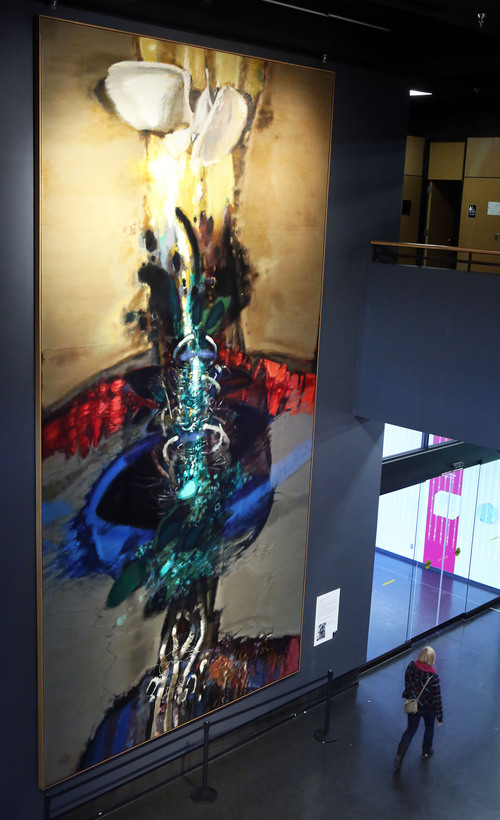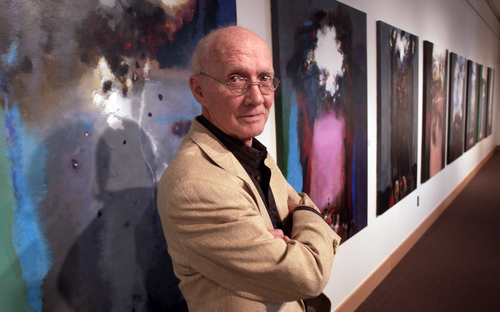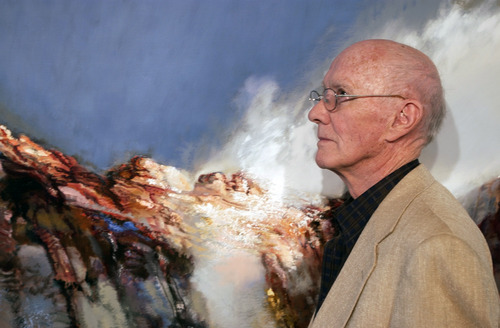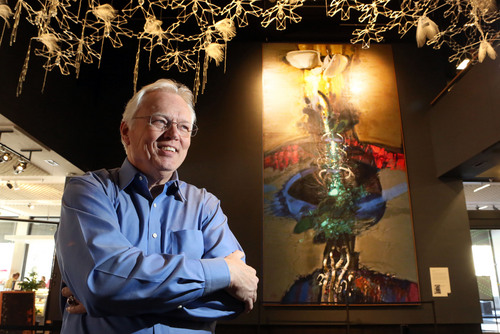This is an archived article that was published on sltrib.com in 2013, and information in the article may be outdated. It is provided only for personal research purposes and may not be reprinted.
The idea for the book "Final Light" started at a dinner among friends. At his Teasdale home in fall 2009, Utah artist V. Douglas Snow, 82, was thinking about his legacy.
"I've always wanted to have a book about my life and work," artist and curator Frank McEntire recalls Snow saying. "And then he looked right at me, and then everybody else at the table looked in my direction."
A strong request, perhaps, but the book project didn't seem too pressing to McEntire. Until, that is, just days later, as Snow was driving from his Wayne County home to Salt Lake City. On Oct. 20, 2009, Snow, a prominent Utah artist and influential retired University of Utah art professor, was killed in a highway rollover.
"It was kind of an interesting personal experience to go through, first at the dinner table, then to have that wish sealed with his death — that certainly changed the dynamics of an obligation," McEntire said.
McEntire assembled a committee that included Susan Snow, Doug's widow; artist Tony Smith; gallery owners Bonnie Philips, in Salt Lake City, and Turkey Stremmel, in Reno, Nev.; art collector Nick Gosdis; and other curators. They began the work of preserving Snow's legacy through "Final Light."
That title encompassed dual exhibitions at the Utah Museum of Fine Arts and the Utah Museum of Contemporary Art in 2011, and an art scholarship to the U. Now comes another chapter of the effort: a beautifully designed coffee-table book, published this summer by the University of Utah Press.
The publication of the book prompts the question: Just what's so significant about Snow's work?
—
'Something important, something urgent' • On its surface, an art book can help enshrine and extend an artist's reputation. "You're not really great unless there's a coffee-table book," jokes artist Shawn Rossiter, the editor of the online arts magazine "15 Bytes" and co-founder of the nonprofit Artists of Utah. Rossiter's essay on Snow's work, "Drama of the Land," is included in "Final Light."
The expense of printing color reproductions means locally published art books are rare. "There are literally only one or two books published about Utah art per year," Rossiter says. "Last year it was LeConte Stewart. This year it's Doug Snow."
According to friends and colleagues, Snow had a healthy ego. He wanted to be considered in the pantheon of great artists, says Smith, a longtime U. colleague and friend. "I get up in the morning primed to do something important, something urgent," Snow once told an interviewer.
"He had taught lots of different people how to see the southern Utah landscape in a unique way, in his way," says Susan Snow. "I think he just wanted to feel that it would continue."
Snow's way meant drawing upon the techniques of abstract expressionism to paint works inspired by Utah scenery. In particular, he was influenced by the Cockscomb, a massive rock formation in Wayne County. The artist positioned his Teasdale studio so that he could view it from his window every day.
"In my judgment, Doug took the language of abstraction and tried to put it back into landscape painting and bring the language up to date," Smith says. "He wanted room for emotions. He liked opera, and Doug wanted his work to visually have that operatic epic grandeur."
In her essay "The Visual Evangelist," writer Teresa Jordan explored Snow's years of teaching. "He has a legacy through his influence," she says.
His paintings, and his way of seeing, have established artistic guideposts. "Artists in Utah, even if they're trying not to be provincial, they can't get away from the landscape," Rossiter says. "You have to deal with it somehow."
For many Utah artists, that means they spend time painting bad Doug Snows before they find their own visual language, in the same way some of Snow's earliest works were heavily influenced by Willem de Kooning.
Reno gallery owners Turkey and Peter Stremmel represented Snow's work for nearly 30 years, becoming close friends with the Snows on the way to selling more than 140 of the artist's paintings. "It's pretty easy to sell a painting when you believe in the painting and you believe in the artist," Turkey Stremmel says.
Reproductions can't always do justice to Snow's brilliant brushwork. He used difficult colors, such as verdigris and ultramarine blue, inspired by his study of the palettes of the Old Master artists. "He knew exactly where he was going to place the brushstrokes on the canvas," Stremmel says. "He loved the land. He had a love affair with Utah, and Utah had a love affair with him."
—
'Bigger than breath' • One of the strengths of the book is the collection of eight essays by longtime friends, writers, artists and curators that aim to put Snow and his work in context. Snow's "great achievement was to bend our gaze full circle from the 'out there' back to the self and convince us that the two are inseparable," writes Will South, the chief curator for South Carolina's Columbia Museum of Art.
By necessity, the book wasn't intended as a comprehensive look at Snow's career. Due to limited time and money, it only focused on Snow's landscape paintings, McEntire says. "Final Light" doesn't explore Snow's illustrations, watercolors, drawings and etchings, or figurative and floral paintings made outside Utah locations.
The essays do, however, suggest the scope of Snow's oversized personality. "He was bigger than breath," Stremmel says. "He was bigger than his stories."
In addition, Snow photographed his works with his own camera, without the professional quality of studio lights, and he wasn't particularly organized. For example, he often used the same title over the span of multiple decades for different paintings, which makes cataloguing his work difficult.
Yet for an art book with more than 80 color reproductions, the book's reasonable price — $26.95 — sets it apart. That required raising more than $50,000 to cover the entire legacy project, which included the exhibitions, an art scholarship and a subsidy for the book's reproductions, according to McEntire.
That was important to Susan Snow, who wanted the book to be affordable to aspiring artists and art students. "Painting is just using pig bristle attached to a stick of some kind to apply pigment to a canvas." That's what Snow would tell anyone who was interested in painting, she recalls.
"He wanted young aspiring painters to know that it's OK to want to be an artist," Susan Snow says. "If you feel driven to be an artist, it's not only OK, it's doable. You can decide when you're 5 years old — like Doug did — and you will be able to survive and have a family and be comfortable. He wanted people to know you can follow your bliss."
For Jordan, the book will keep Snow's work alive for her and future generations of artists. "I don't own a piece of Doug's work, so I love the book because I get to have his work in my home."
facebook.com/ellen.weist —
'Final Light: The Life and Art of V. Douglas Snow'
The art book published by the University of Utah Press sells for $26.95 at local bookstores and online.
About Doug Snow
Born • In Salt Lake City in 1927
Early life • Sold his first painting, "View of the City at Dusk," at age 14. Delivered it to the buyer on a bicycle. Studied theater at the University of Utah in 1943-45; also studied art with LaConte Stewart.
Inspiration • Snow's mother, Loree Forsyth, was born in Loa, northwest of Teasdale. Her three children didn't visit southern Utah until Doug was 18. "We fell in love with the place as soon as we saw it," he said.
Art training • In 1946, Snow studied at New York's American Art School and Columbia University; earned a master's degree from the Cranbrook Academy of Art in Michigan in 1950; awarded a Fulbright Scholarship to Rome's Academy of Fine Arts.
Academic career • Taught at Stanford University and Wayne State College before coming to the University of Utah in 1954. Chaired the art department from 1966-71. Retired in 1992.
Work • Included in collections at New York's Museum of Modern Art, the San Francisco Museum of Modern Art, the Utah Museum of Fine Arts, the Springville Museum of Art and the Museum of Art at Brigham Young University.
Public commissions • Snow was best known in Utah for his murals, including one hanging in the lobby of The Leonardo (commissioned when the building was the Salt Lake Library), at the Rio Grande Gallery (originally in the lobby of the U.'s Pioneer Theatre), and "Capitol Reef," which hangs behind the Supreme Court bench in the Matheson Courts Building. The painting is covered with a gray curtain and is visible only when the court isn't in session, which seems fitting in terms of the mural's original title, "Conflict and Resolution."
Died • Oct. 20, 2009 Viewing Doug Snow's work
The Stremmel Gallery in Reno has 26 works by Doug Snow for sale. The gallery has sold 140 of his paintings over the past three decades.
Value • After Snow's death in 2009, the value of his works has risen. For example, in 1995 a 48-by-60-inch painting by the Utah artist sold for $5,500 at the gallery. Now that same painting is priced at $11,250. In 1990, a 43-by-60-inch painting sold for $6,700. Now the artwork is valued at $11,175.









